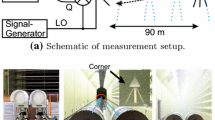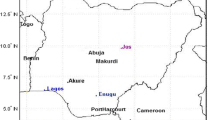Abstract
The combined effects of hydrometeor scattering and absorption result in significant power loss, for Earth-space microwave links operating at frequencies above 10GHz. With the increasing deployment of higher frequencies in commercial wireless networks, the accurate estimation of the specific rain attenuation is very significant for the reliable design of a radio communication system. In the present paper, the scattering of a plane electromagnetic wave from a Pruppacher-Pitter raindrop is treated using the Method of Auxiliary Sources (MAS). The obtained data are compared with those taken from the open literature -in the form of real and imaginary part of the forward scattering amplitude - with excellent results. Then, they are used for the numerical calculation of both the specific rain attenuation and the exceedance probability function, in the case of a hypothetical satellite link located in various climatic regions. The comparison with other models against experimental data has given very encouragingresults.
Similar content being viewed by others
References
[1] R. K. Crane,“Electromagnetic Wave Propagation through Rain,” John Wiley & Sons, Inc., New York, 1996.
[2] T. Oguchi, “Attenuation of electromagnetic wave due to rain with distorted raindrops,” J. Radio Research Labs., vol.7, pp.467–485, 1960.
[3] T. Oguchi, “Attenuation of electromagnetic wave due to rain with distorted raindrops (Part II),” J. Radio Research Labs., vol.11, pp.19–44, 1964.
[4] J. A. Morrison and M.J. Cross, “Scattering of a plane electromagnetic wave by axisymmetric raindrops,” Bell Syst. Techn. Journ. vol.53, pp.955–1019, 1974.
[5] A.R. Holt, N.K. Uzunoglou and B. G. Evans, “An integral equation solution to the scattering of electromagnetic radiation by dielectric spheroids and ellipsoids,” IEEE Trans. Antennas Propagat, vol. AP-26, pp.706–712, 1978.
[6] L.-W. Li, P.-S. Kooi, M.-S. Leong, T.-S. Yeo and M.-Z. Gao, “Microwave Attenuation by Realistically Distorted Raindrops: Part I — Theory,” IEEE Trans. Antennas Propagat, vol. AP-43, pp.811–822, August 1995.
[7] D.-P. Lin and H.-Y. Chen, “Volume Integral Equation Solution of Extinction Cross Section by Raindrops in the Range 0.6–100GHz,”, IEEE Trans. Antennas Propagat, vol. AP-49, pp.494–499, March 2001.
[8] D. I. Kaklamani and H. T. Anastassiu, “Aspects of the Method of Auxiliary Sources (MAS) in Computational Electromagnetics,” IEEE Antennas and Propagation Magazine, vol.44, no.3, pp. 48–64, June 2002.
[9] N. K. Uzunoglu, B. G. Evans, and A. R. Holt,“Scattering of Electromagnetic Radiation by Precipitation Particles and Propagation Characteristics of Terrestrial and Space Communication Systems,” Proc. IEE, Volume 124, No 5, May 1977.
[10] H. R. Pruppacher and R. L. Pitter, “A Semi-Empirical Determination of the Shape of Cloud and Rain Drops” Journal of the Atmospheric Sciences, Volume 28, pp. 86–94,June 1970.
[11] L.-W. Li, P.-S. Kooi, M.-S. Leong, and T.-S. Yeo, “On the simplified expression of realistic raindrop shapes,” Microwave Opt. Technol. Letters, vol. 7, no.4, pp.201–205, 1994.
[12] Leviatan Y., Boag A., and Boag A., “Generalized Formulations for Electromagnetic Scattering from Perfectly Conducting and Homogeneous Material Bodies-Theory and Numerical Solution,” IEEE Transactions Antennas Propagat, volume 36, No 12, December 1988.
[13] Tsuji M., Shigesawa H. and Nishimura M., “Theoretical and experimental study of three dimensional scattering problems,” IEICE Transactions E-74, 9, pp.2848–2854, 1991.
[14] Tsuji M. and Shigesawa H., “Scattering form perfect conducting cylinders of finite length: calculations by means of multiple equivalent dipoles and experiments,” J. Electromagnetic Waves and Applications, vol. 8, pp.471–488, 1994.
[15] Oguchi T., “Scattering Properties of Pruppacher and Pitter Form Rain Drops and Cross Polarization due to Rain: Calculations at 11, 13, 19.3 and 34,8 GHz”, Radio Science, Volume 12, No 1, pages 41–51, January–February 1977.
[16] Olsen R.L., Rogers D.V., and Hodge D.B.,“The aRb relation in calculation of rain attenuation”, IEEE Trans. on Antennas and Propagation, Vol. 26, No. 2, pp. 318–329, 1978.
[17] ITU-R, “Propagation data and prediction methods required for the design of Earth-space telecommunication systems,” Propagation in Non-Ionized Media, Rec. P.618-8, Geneva, 2003
[18] ITU-R, “Specific attenuation model for rain for use in prediction methods,” Propagation in Non-Ionized Media, Rec. P.838-2, Geneva, 2003.
[19] Ishimaru A., “Wave Propagation and Scattering in Random Media, Volume I: Single scattering and transport theory; Volume II: Multiple scattering, turbulence, rough surfaces and remote sensing, 572 pages, IEEE Press-Oxford University Press Classic Reissue, 1997.
[20] Marshal J. S. and W. McK. Palmer, “The distribution of raindrops with size”, Jour. Meteorol., Vol.5, p. 165–166, 1948.
[21] Ajayi G.O. and Olsen R.L.,“Modelling of raindrop size distribution for microwave and millimetre wave applications”, Radio Sci., Vol. 20, Mar./Apr., p. 193–202, 1985.
[22] Garcia-Lopez, J.A., Hernando, J.M. and Selga, J.M.; Simple rain attenuation prediction method for satellite radio links, IEEE Transactions on Antennas and Propagation, vol. 36, 3, March 1988, pp. 444–448.
[23] International Telecommunication Union, http://www.itu.int/ITU-R/Software/study-groups/rsg3/databanks/index.html
[24] Ray P.S., “Broadband Complex Refractive Indices of Ice and Water” Applied Optics, Volume 11, No 8, August 1972.
[25] S. A. Kanellopoulos, A.D. Panagopoulos and J.D. Kanellopoulos “Analysis of Electromagnetic scattering by a raindrop using the Method of Auxiliary Sources”, IEEE International Symposium on Antennas and Propagation and USNC/URSI National Radio Science Meeting, Monterey, California, pp. 4176–4179, June 2004.
[26] Moupfouma F., “A New Theoretical Formulation For Calculation Of the Specific Attenuation Due to Precipitation Particles on Terrestrial and Satellite Links”, International Journal of Satellite Communications, Volume 15, pages 89–99,1997.
[27] ITU-R, “Rain height model for prediction methods,” Propagation in Non-Ionized Media, Rec. P.839-3, Geneva, 2001.
[28] ITU-R, “Characteristics of precipitation for propagation modeling,” Propagation in Non-Ionized Media, Rec. P.837-3, Geneva, 2001.
Author information
Authors and Affiliations
Corresponding authors
Rights and permissions
About this article
Cite this article
Kanellopoulos, S., Panagopoulos, A. & Kanellopoulos, J. Calculation of Electromagnetic Scattering from a Pruppacher-Pitter Raindrop Using M.A.S. and Slant Path Rain AttenuationPrediction. Int J Infrared Milli Waves 26, 1783–1802 (2005). https://doi.org/10.1007/s10762-005-0297-0
Received:
Published:
Issue Date:
DOI: https://doi.org/10.1007/s10762-005-0297-0




